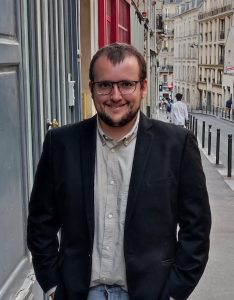 Morphological changes are critical for the virulence of a range of human fungal pathogens. Antonio SERRANO SALCES postdoctoral work, in Robert ARKOWITZ lab, is focused on understanding morphogenesis in the opportunistic human pathogenic fungus Candida albicans.
Morphological changes are critical for the virulence of a range of human fungal pathogens. Antonio SERRANO SALCES postdoctoral work, in Robert ARKOWITZ lab, is focused on understanding morphogenesis in the opportunistic human pathogenic fungus Candida albicans.
Fungi grow by hyphal extension at the apex, and the transitions between yeast-to-hyphae (filamentation) and hyphae-to-hyphae (hyphal branching) are crucial for the pathogenesis. The main goal of Antonio’s project is to understand how hyphal branching is regulated and its specific role during the infection process. For this he is using live-cell imaging, micro-rheological probes, and response to antifungal drugs.
At the end, he expects “to be able to explain the how, when, and where hyphal branching is happening, the mechanisms underlying this process and its implications during infection.”
Antonio is from Córdoba, a city in the region of Andalucía, the south of Spain. He studied at the University of Córdoba where he first obtained a bachelor’s degree in biology and “discovered the fascinating world of microbiology, and more specifically, fungal biology.”
After a “wonderful” experience at the lab during his master thesis (awarded with the best Master thesis at the University of Córdoba of 2014), he decided to continue in research and pursue a PhD.
In Sept 2014 Antonio joined the lab “Braunschweig Fungal Genetics” of Prof. André Fleissner at the Technische Universität Braunschweig, in Germany, to investigate the process of cell fusion in fungi (funded by the EU Marie Curie program Initial training network “Fungibrain”).
“Cell fusion is a quite interesting process, not only for fungal growth but also important in cancer pathogenesis and some other diseases, so by using a filamentous fungus as a model, we could decipher part of the disease development. “
After “a very happy experience” in Germany during his PhD and with the thesis under his belt, Antonio decided to continue in academic research, and joined the group of Rob Arkowitz in 2020 as a postdoctoral researcher to investigate Candida albicans morphogenesis and pathogenicity. Recently, he has obtained support from a Marie Curie Individual fellowship (BranchOut). More, in March 2022, he won an award for his poster presented at the 31st Fungal Genetics Conference organized by the Genetics Society of America.
Antonio why did you choose iBV?
One of the things that I most like in research is cell imaging. For this, you need a good microscopy facility which can give you the opportunity to learn from experts and to have access to incredible microscopes. After my PhD, I decided I wanted to join a lab with extensive expertise in fungal live-cell imaging and an institute with access to a range of different microscopes and a highly reputable microscopy platform, so the iBV was my first option. This, together with the fact that Nice is a wonderful and very welcoming city (which I knew beforehand from a visit for an ITN meeting).
What is your motivation at work?
I consider myself to be a person driven by curiosity; this has helped me a lot at work. I always wonder about why and how things happen in nature and being able to see live subcellular processes with my own eyes (through the microscope) is something that has always fascinated me. Learning and fulfilling my curiosity by helping society and increasing our knowledge of nature are my main motivation at work.
What could be the impact of your work for health?
Fungal infections are more and more common with higher mortality rates in the recent years. New species of pathogenic fungi have emerged worldwide presumably because of the increase in the global temperature due to climate change. This, together with the fact that the effect of antifungals and their availability is limited, places more importance on the research of how pathogenic fungi grow and result in infections. Besides, hyphal branching is not limited to Candida spp. but present in virtually all filamentous fungi, making my research applicable to plant pathogenic fungi, mycorrhizae, etc. I expect that the understanding of hyphal branching may open a new target for future antifungal therapies for the society, not only for humans but also for food security.
What are your plans for the future?
My main goal is to remain in research in the academic sector in Europe, preferentially France or Spain, working on a fungal-related topic. However, I understand that it can be difficult to get an academic position, therefore I am also open to continue my research, in a more applied area, in the private sector, hopefully in the fungal field!

